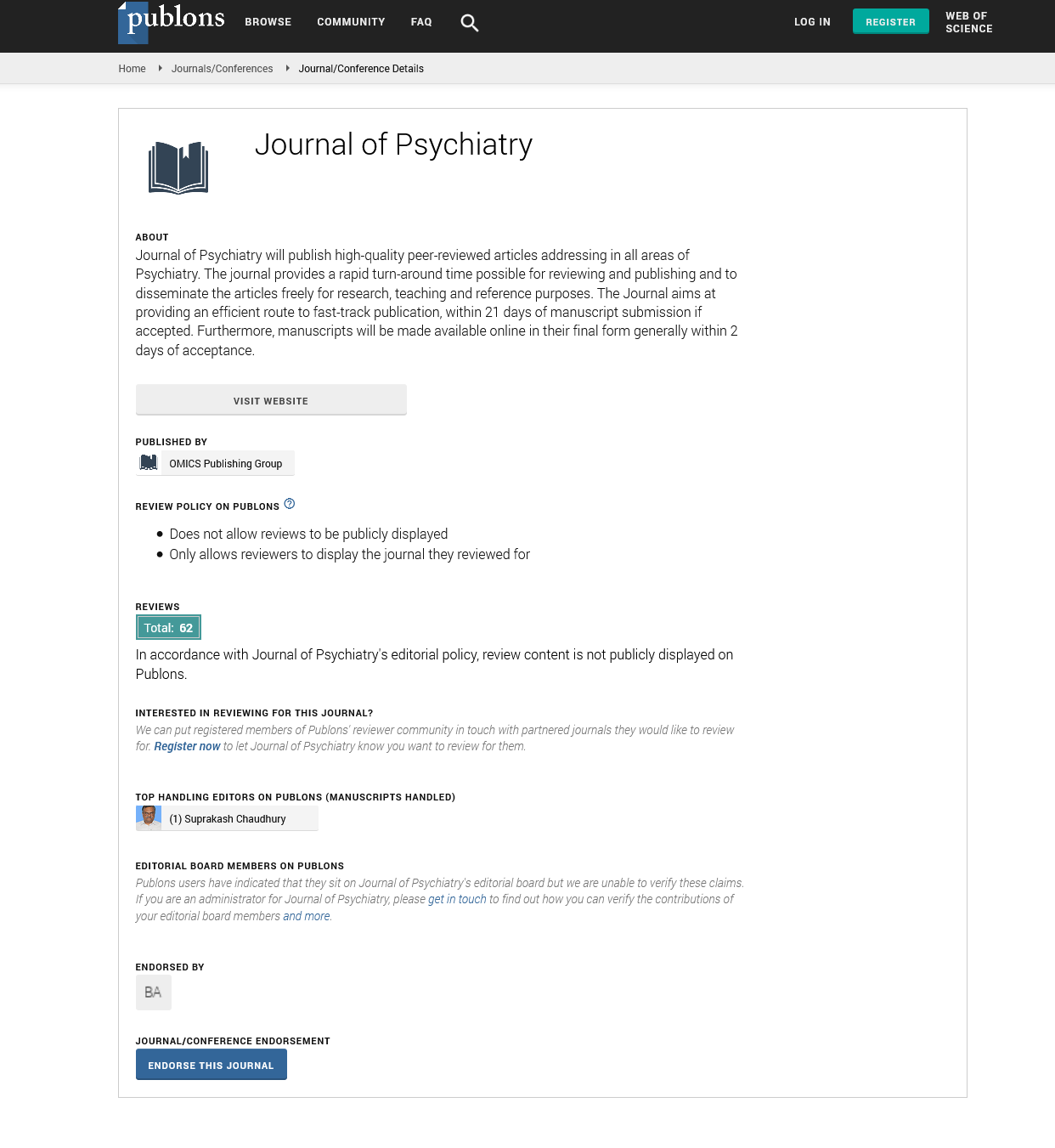Indexed In
- RefSeek
- Hamdard University
- EBSCO A-Z
- OCLC- WorldCat
- SWB online catalog
- Publons
- International committee of medical journals editors (ICMJE)
- Geneva Foundation for Medical Education and Research
Useful Links
Share This Page
Open Access Journals
- Agri and Aquaculture
- Biochemistry
- Bioinformatics & Systems Biology
- Business & Management
- Chemistry
- Clinical Sciences
- Engineering
- Food & Nutrition
- General Science
- Genetics & Molecular Biology
- Immunology & Microbiology
- Medical Sciences
- Neuroscience & Psychology
- Nursing & Health Care
- Pharmaceutical Sciences
Commentary - (2022) Volume 25, Issue 9
Examination of Depression Symptoms Using Accurate Scales and Specification of Neuronal Circuits
Kevin Wahl*Received: 01-Sep-2022, Manuscript No. JOP-22-18454; Editor assigned: 05-Sep-2022, Pre QC No. JOP-22-18454(PQ); Reviewed: 19-Sep-2022, QC No. JOP-22-18454; Revised: 26-Sep-2022, Manuscript No. JOP-22-18454(R); Published: 03-Oct-2022, DOI: 10.35248/2378-5756.22.25.528
About the Study
Since the introduction of electroconvulsive therapy in 1938 for the treatment of schizophrenia, Electroconvulsive Therapy (ECT) has been one of the most successful therapies for serious mental illnesses such major depressive disorder and schizophrenia for more than 80 years. The use of ECT did, however, drop for a period of time because of the anti-psychiatric movement, aversion to electricity, and worries about adverse consequences like cognitive loss and cardio-cerebrovascular illness. Furthermore, the restricted use of ECT may have been influenced by the emergence of several pharmaceutical treatments. Since then, measures have been taken to reduce the negative effects of ECT, such as the use of general anesthesia, the use of right unilateral electrodes and sine waves in addition to bitemporal electrodes, and the altering of settings for each patient.
The main reason to use ECT is major depression. The remission and response rates are respectively more than 50% and 70%. When a patient exhibits severe depressive symptoms during an acute episode and also exhibits a significant risk of suicide or psychotic symptoms, index ECT is specifically taken into consideration. To achieve remission, avoid relapse, and enhance quality of life, it is imperative to choose and treat patients who are anticipated to respond favourably to ECT in the early stages of an episode. As it is already indicated, numerous research have looked into the predictors of the ECT response in major depression in addition to the shorter duration of the episode. Old age, associated psychotic symptoms or catatonia, and lack of treatment failure are predictors that have been generally consistent thus far.
The beneficial benefits of index ECT on major depression, emphasising the temporal variations in symptom dimensions. In the early stages of the index ECT treatment, depression symptoms improved quickly, as in earlier investigations. These are our key conclusions: First off, compared to the other dimensions, the depression dimension exhibited a longer period of substantial improvement. Second, only in the depression and anxiety dimensions did a substantial difference in the amount of improvement between the remitter and non-remitter groups start to emerge and persist after at least six ECT treatments. Third, the depression dimension continued to exhibit larger T-score reduction from baseline than the other three dimensions up to the twelfth ECT session.
The "general depression factor," which included "depressive mood," "guilt," and "suicide" items, was found in the metaanalysis of HDRS factors. This factor was remarkably comparable to the depression dimension in our study. Early, intermediate, and delayed insomnia were all grouped together into the category of "insomnia," which was also used in other research. Numerous research have also employed the "anxiety/ agitation component," which consists of agitation, psychological anxiety, and somatic anxiety; our study referred to this element as the anxiety dimension. Finally, to analyse the trajectory of somatic symptoms during the index ECT course, our study used weight loss, genital symptoms, general somatic symptoms, and gastrointestinal somatic symptoms as somatic symptoms dimensions.
The drop in the HDRS-17 total score was more noticeable during the considerable improvement period and up until the sixth ECT session, and the depression dimension continued to improve noticeably longer than the other three dimensions. In line with earlier studies, the HDRS-17 total score decreased quickly during the initial stages of index ECT. In fact, many studies have looked at how ECT affects the overall scores on depression rating scales, and more recent studies have looked at how individual depressed symptoms progressed over the index ECT period. But only a small number of research to date have pinpointed the time frame in which each depression symptom component continues to decline significantly.
When ECT was administered to patients, the depression dimension improved more than other dimensions. To prevent an early end to ECT and recurrence, it may be desirable to deliver at least six treatments. The therapeutic benefit may be enhanced by controlling other depressive symptoms, such as sleeplessness. Additional research evaluating depression symptoms using more precise scales and describing the neural pathways related to each dimension is required.
Citation: Wahl K (2022) Examination of Depression Symptoms Using Accurate Scales and Specification of Neuronal Circuits. J Psychiatry. 25:528.
Copyright: © 2022 Wahl K. This is an open-access article distributed under the terms of the Creative Commons Attribution License, which permits unrestricted use, distribution, and reproduction in any medium, provided the original author and source are credited.

